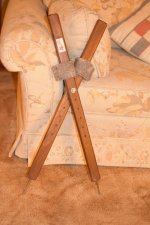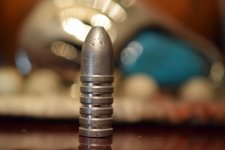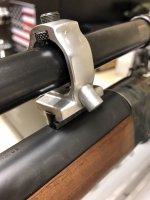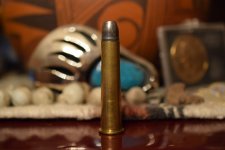rooster,
When I got started with my High Wall, I was forming 40-65 brass by running 45-70 brass into a borrowed Redding forming die IIRC, using Imperial Sizing Die Wax. Brass worked fine, though it would've been nice to have had correct head stamp on it. Since then, Starline now makes 40-65 brass with correct head stamp. I formed quite a bit of 40-65 brass to feed the High Wall as well as an original Winchester model 86 lever rifle made in 1897, with a round bbl that had been chopped off at 22", and had a rough bore with lots of pits. That old rifle had been around several members in our club before I bought it, and no one had much success in getting it to shoot with much accuracy. I bought a Lyman mold to cast the same 260gr bullets that original factory ammo was loaded with - the barrel had a 1-22 twist for these light 'express' bullets. I bought the same sort of granulated polymer called "grex" that factory buckshot loads use to cushion 00 buck pellets and thereby prevent gross deformation, and loaded it on top of the powder charge to prevent melting the base of these bullets, and the old rifle shot pretty darned good with very little leading - this was with smokeless powders like AA2015 & H4895, loaded to give the same velocity as the old BP factory loads, in the 1200-1300fps range. It's been nearly 30yrs since I played with that old rifle, but it's earned its place in the safe, along side a few other old Winchester lever rifles and one nice High Wall in 32-40.
I tried casting the #740 for the High Wall using a RCBS 22lb electric furnace, but soon gave up and bought a couple of cast iron plumbers pots and welded up a LP fired furnace with rails around the edge to rest the molds on to pre-heat them while the 1-20 alloy was melting in the pot. Bought a Lyman casting thermometer, and worked to keep the alloy temp stable by fine-tuning the valve on the burner. Of course, had to use a dipper to fill out of the pot, but the combination of keeping temp stable, careful fluxing, and filling the molds by starting with the mold held in a horizontal position with the dipper spout held against the sprue plate, then smoothly rotating mold and dipper to vertical to fill the cavity, resulted in some well filled-out bullets with consistent weight and very few visible defects (unlike the bullet in the photo I posted). Some days it seemed easy to cast acceptable bullets, other days it seemed like I could do nothing right, but it was almost always my own mistakes that caused problems. It takes some patience & skill to cast perfectly filled-out bullets with consistent weights (which usually means no internal voids), but that's what it takes to produce consistent loads capable of hitting the rams at 500M. But when you've got the process nailed down, it's rewarding to have success at it.











